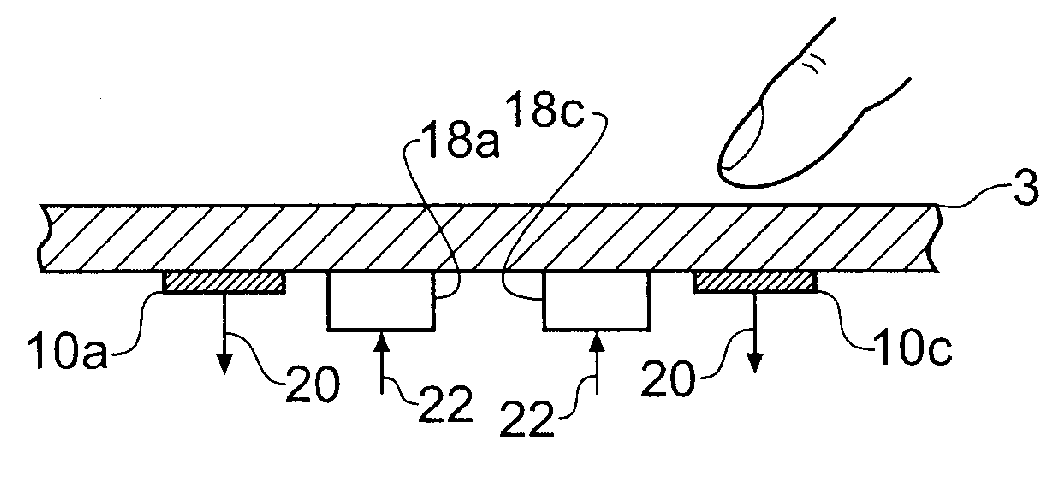[0005] By allowing certain functions of the appliance to be activated only in response to a pre-determined combination of at least two selections from the plurality of proximity sensor areas, the chance of accidentally activating these functions is reduced. This provides for a domestic appliance which benefits from the advantages of a touch-sensitive control panel but does not suffer the drawback of being prone to inadvertent activation. This provides for a safer appliance. The complexity of the predetermined combination may be selected according to the level of protection against inadvertent activation required. In addition, an elegant and uncluttered control panel can be designed whereby a number different functions are associated with a relatively small number of common sensor areas, the functions being activated according to different pre-determined combinations.
[0006] The pre-determined combination may correspond to a user selecting at least two different proximity sensor areas or to a user selecting a single proximity sensor area at different times. To further reduce the chances of inadvertent activation, the pre-determined combination of at least two selections may need to be made within a specified time period. For example, the combination of selections may need to be made within a time period less than 5, 4, 3, 2, 1, 0.5 or 0.1 seconds. Similarly, selections made within the combination may need to separated by a minimum time such that the specified time within which they are made is more than 0.1, 0.2, 0.3, 0.4, 0.5, 1, 2 or 5 seconds, in order to activate the function with which they are associated.
[0007] In some embodiments of the invention, a function of the appliance activated in response to a user making the pre-determined combination of at least two selections may be subsequently cancelled by the user making only one of the selections comprising the pre-determined combination. For example, a user may be required to select both of two separate proximity sensor areas within a one-second time period in order to switch on an appliance from a stand-by mode. If these two sensor areas are closely spaced, the user can switch on the appliance with a simple sliding motion of his finger from one sensor area to the other. To avoid the need for separate sensor areas for switching the appliance off, the sensor areas associated with switching on the appliance can also be used to switch the appliance off. If desired this can require a similar combination of selections as are required to switch the appliance on. However, in general it is less dangerous to have an appliance accidentally switched off. For safety reasons, switch off should also be an easy operation to perform. It may thus be considered preferable to allow the user to switch off the appliance by selecting any one of the two sensor areas used to switch on the appliance without requiring any predetermined combination of selections to be made.
[0008] In many appliances the use of a position sensitive proximity sensor area for which the driver circuitry is operable to output a detection signal dependent on the position of a touch within said position sensitive proximity sensor can assist operation of the appliance. For example a variable operating parameter of the appliance, such as temperature of a hob or speed of a food blender or washing machine drum, can be varied according a position detected by the position sensitive proximity sensor area. This provides a rapid and intuitive way for a user to set a variable parameter. In order to configure the position sensitive proximity sensor area to vary the variable operating parameter of the appliance, a user may be required to make a pre-determined combination of at least two selections from the plurality of proximity sensor areas, one of which being a selection of the position sensitive proximity sensor. This can help to provide against inadvertent adjustment of the variable parameter. In addition by allowing different variable operating parameters of the appliance, e.g. the temperatures of different heating elements in an oven, to be adjusted with the same position sensitive proximity sensor depending on other selected sensor areas, a number of different variable parameters may be adjusted by a control panel having only one position sensitive proximity sensor area. Position sensitive proximity sensor areas are generally relatively complex and extend over a larger area than more basic binary detectors. Accordingly, a simple and uncluttered control panel can be provided.
 Login to View More
Login to View More  Login to View More
Login to View More 


